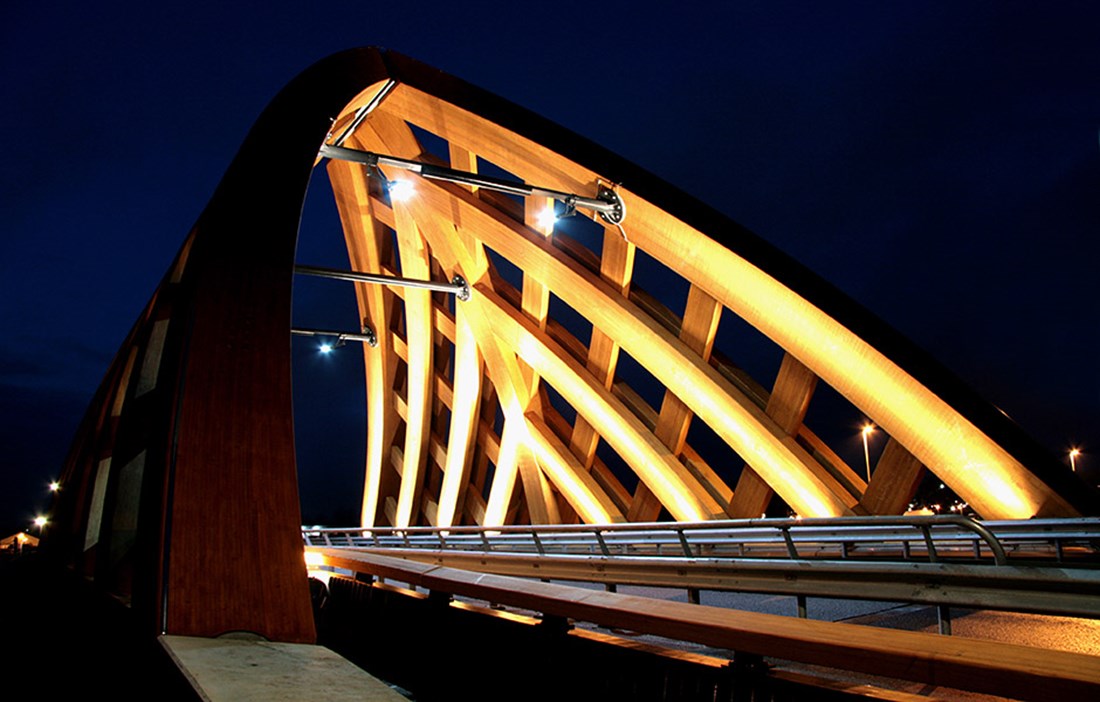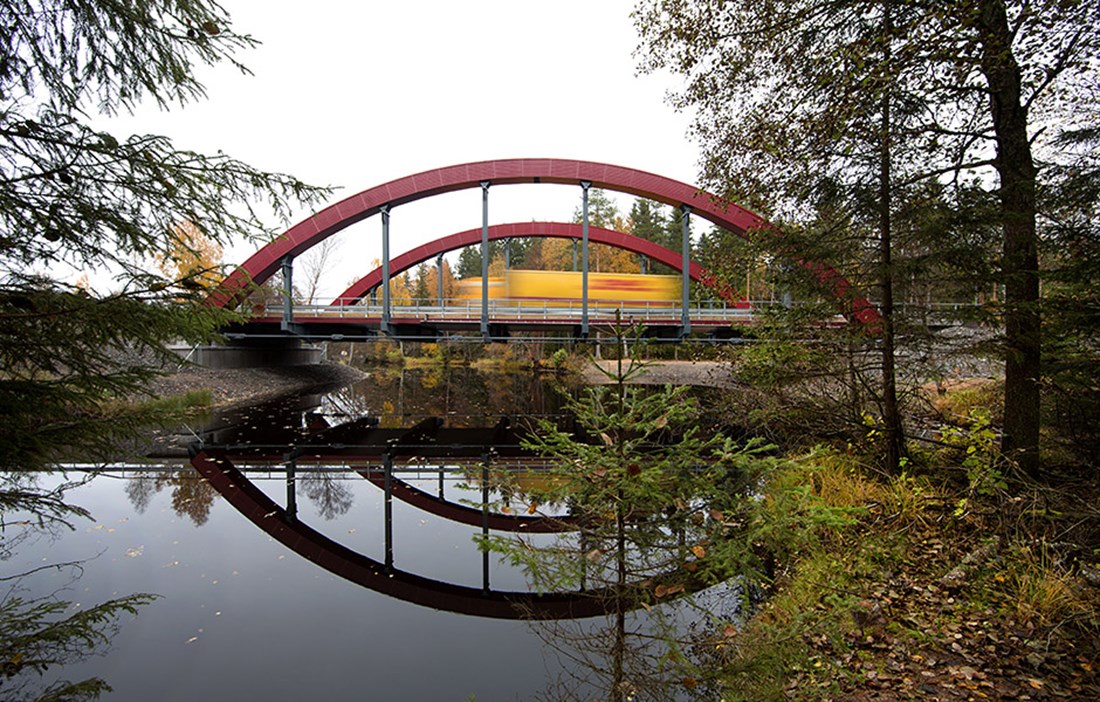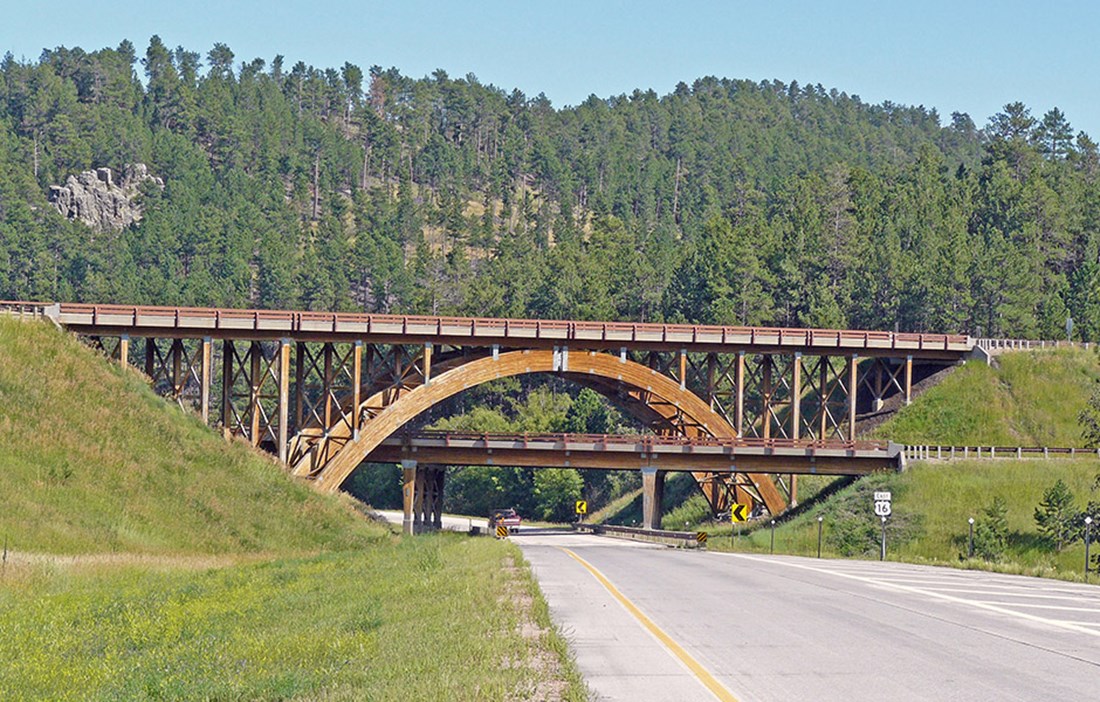TWO MIGHTY ARCHES in glulam span the dark waters of the Nissan river. Route 27 has gained a new stretch of road thanks to Sweden’s longest tied-arch road bridge in wood. The bridge outside Gislaved opened in early October, following only six weeks of assembly work on site. The wooden bridge was prefabricated off-site and then transported to its end location.
“It makes the construction process shorter and less expensive. In this case, we also avoided the need to erect scaffolding across the water,” says Stefan Bergström, project manager at Moelven.
The biggest challenge was getting the six hangers that hold up the deck to fit into the arches.
“To ensure the correct fit, it was essential that the work in the factories was extremely precise.”
The deck of the bridge comprises 225 glulam beams tensioned with iron rods. The beams were glued together from a huge quantity of timber strips in Moelven’s factory in Töreboda. Around 260 m³ of glulam beams were required for the deck, and around 100 m³ for the arches. Stefan Bergström explains that wood requires little maintenance if handled correctly. The material is eco-friendly and easy to recycle. It is also easy to shape to give bridges an exciting design.
To reduce the risk of rot and other damage to the glulam beams, they have been clad in spruce panelling. In certain exposed places, the panelling has then been clad in sheet metal to further reinforce the weatherproofing. The cladding can then easily be replaced if necessary at a later date.
“We estimate that the bridge will last 80 years, largely due to the protective shell and good drainage zones for water. Air gaps and drainage zones help to keep the glulam dry,” says Stefan Bergström.
The shape of Gislavedbron bridge is based on the guidelines issued by the Swedish Transport Administration in 2010, in its design programme for Route 27. Here the administration states that the bridge must harmonise with the curves of the Nissan river and have a bold and individual design.
THE POSSIBILITY OF CREATING cost-effective and climate smart bridges that at the same time allow for interesting architecture is an important competitive advantage according to Peter Jacobsson, development manager at Martinsons Träbroar, which makes wooden bridges.
“It’s important to show just what can be done with wood as a construction material. I feel we’re seeing much greater acceptance of bridge designs in wood,” he states.
In autumn 2013, Peter attended an international wooden bridge conference in the USA. Researchers and industry representatives from around the world gathered in Las Vegas to discuss construction techniques and durability. Peter’s contribution was to talk about building Älvsbackabron, a cable-stayed bridge for pedestrians and cyclists that spans the Skellefteälven river. The conference programme was illustrated with a picture of the impressive double bridge in Keystone Wye that provides an interchange for routes US 16 and US 16a in South Dakota. The top bridge is 88 metres long, with an arch span of 49 metres.
“It’s amazing. The arch is a key component of the impressive design, but above all it’s the fact that it is built over two levels that makes it special. It’s the only bridge of its kind that I know of,” says Peter Jacobsson.
AKKERWINDE BRUG IN the Netherlands is another spectacular wooden design. Gothic forms and Friesian boatbuilding traditions inform the bridges that for a few years now have led into central Sneek, a town of just over 30,000 people. In partnership with architectural firm Onix, architect Hans Achterbosch and his colleagues accepted an invitation from the town and the province of Friesland to enter the competition to design two road bridges in wood over the A7 motorway.
“The design had to be functional and at the same time good-looking. We thought, well this is a competition, so you expect something extra and that is what you’ll get,” says Erik Jan Tabak of Achterbosch Architectuur.
Each bridge comprises two arches that hold up a 32 metre long and 14 metre wide deck. The height is 16 metres. To handle heavy traffic and live up to the client’s other requirements, exceedingly high performance wood was required. The choice went to Accoya, which in this case was created out of commercially grown pine from New Zealand. The wood has been pressure treated with acetic anhydride in a system known as acetylation. This treatment process gives the wood similar properties to tropical hardwood, with high resistance to mould and insect attack.
The arched shape provides optimum space for traffic. The two arches were lifted into position using six cranes and are joined in the middle to provide the greatest possible stability.
The town celebrated in 2010 when both bridges were completed. The impressive shape has also caused ripples in architectural circles. The bridges were shortlisted for the Dutch BNA Building of the Year award and won the prize for the most striking building in Sneek.
BUILDING BRIDGES IN WOOD has deep roots in Europe, and those roots perhaps run deepest in Switzerland. The website Swiss Timber Bridges lists almost 1, 500 wooden bridges, of which 500 or so can be crossed in lighter or heavier vehicles. One of these is Punt la Resgia near the little village of Ramosch, close to the border with Austria and Italy. The 46 metre long bridge is a combination of trusses and an arch, which makes the bridge even stronger.
The clearest indication that the bridge follows Swiss woodworking traditions is the roof. Punt la Resgia was built in its current form in 1990, although there was previously a simpler version that crossed the river Inn at the same point. Switzerland has around 350 covered bridges. The roof protects the wood and means that many of the oldest bridges, which were constructed several hundred years ago, are still in use.
Text Torbjörn Tenfält























